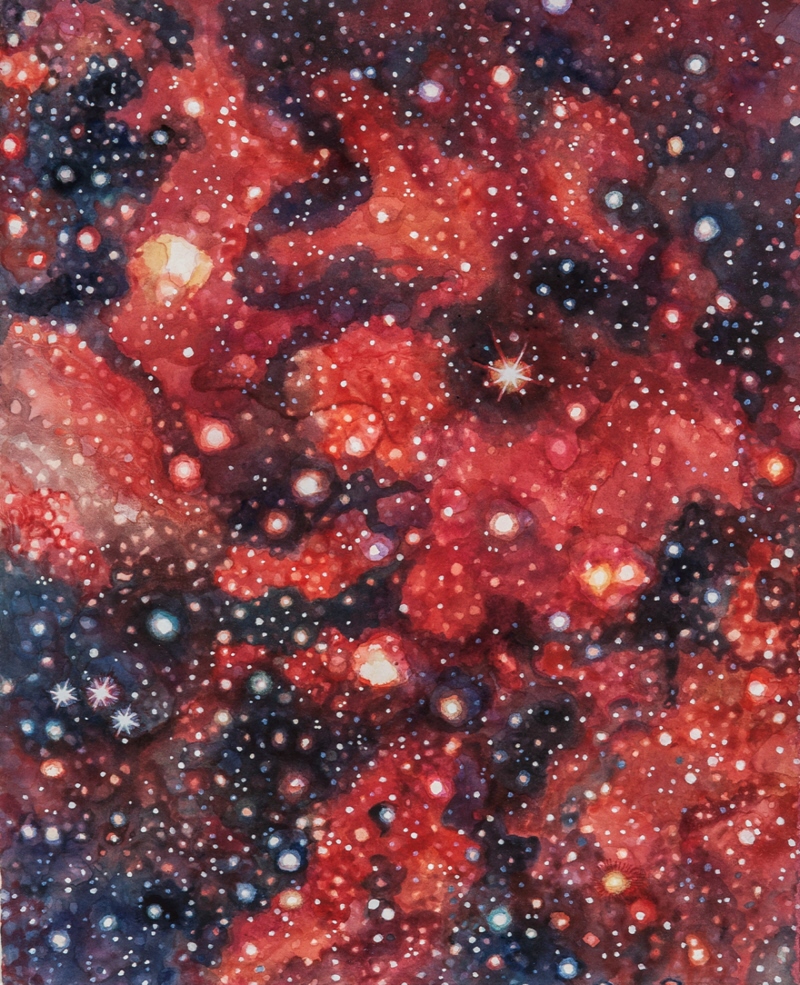 Jane Goldman
Jane Goldman
Seeing Infra Red 2
Watercolor monotype & gouache
…..
Howard Smith
Astrophysics
Center for Astrophysics / Harvard & Smithsonian
I am an astronomer who looks at the universe in the infrared — wavelengths that the eye cannot see – the invisible universe. Many of the brightest, biggest, youngest, oldest, strangest, or most energetic objects in the cosmos are invisible to the eye. Although I often travel to mountaintops where telescopes with special infrared-sensitive cameras image the deep sky, just as often, I download data from infrared telescopes on satellites orbiting in space. The data, when displayed on a color screen, reveal the composition, history, and motions of the gas and dust, and help to tell the story of how stars are born and how our galaxy evolved.
The infrared also reveals the invisible universe to be much more than the stars. The vast spaces between stars are filled with gas and dust that glow in the infrared, disclosing giant clouds from which new stars form, filaments and wisps of gas ejected by stellar winds, and the Milky Way’s own natal material. The infrared emission comes from material that is much cooler than stars, often less than -100 degrees C, but it is bright in the infrared. Jane’s piece beautifully captures the sense of this rich, invisible world.
As a scientist, I work to see things as they reveal themselves in the data, and then put together a story – a “picture” – that offers explanations: what it is, with context and personality. Although other astronomers might use the same data to figure out the same story line, the stories we tell will be as different as our individual creative energies which flesh out the details. Perhaps in the artistic process something similar is going on?

Je suis un astronome qui regarde l’univers en infrarouge, les ondes
que l’oeil ne peut voir, l’univers invisible. La plupart des objets les
plus brillants, les plus gros, les plus jeunes et les plus vieux, les
plus bizarres ou les plus énergétiques du cosmos sont invisibles
à l’oeil nu. Bien que je visite souvent le haut des montagnes où
les télescopes avec des caméras à infrarouge photographient le
ciel profond, c’est aussi souvent que je télécharge les données de
télescopes installés sur des satellites qui orbitent en espace. Quand
ces données sont étalées sur un écran en couleur, elles révèlent
la composition, l’histoire et les mouvements de gaz et poussières
et nous aident à raconter l’histoire de la naissance des étoiles et
l’évolution de notre galaxie.
L’infrarouge révèle que l’univers invisible va au delà des étoiles. Les
vastes espaces entre les étoiles sont remplis de gaz et de poussières
qui brillent en infrarouge, qui révèlent des nuages gigantesques
dont naissent des nouvelles étoiles, des filaments de gaz éjectés par
des vents stellaires, et le matériel de naissance de la Voie Lactée.
Ces émissions infrarouges viennent de matériels bien plus froids
que les étoiles, parfois plus froids que -1OO degrés Celsius, mais
ils brillent. L’oeuvre de Jane capture brillamment la richesse de ce
monde invisible.
En tant que scientifique, je travaille à voir les choses comme elles
se révèlent par les données, et construis ensuite une histoire.
Cette image offre des explications sur ce que ces choses sont, leur
contexte et personnalité. Bien que d’autres astronomes utilisent les
mêmes données pour déduire la même histoire, celles que nous
racontons seront aussi différentes que nos énergies créatives qui
les détaillent. Peut être que le procédé artistique suit un parcours
similaire?